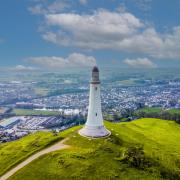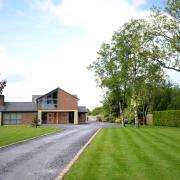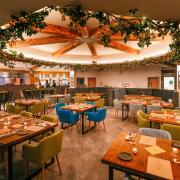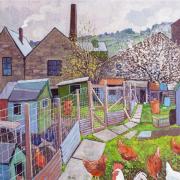Phil Martin’s lifelong love of history has led him to create intriguing ‘then and now’ comparison pictures of landmarks in his home city of Lancaster. The images are now winning him fans on social media where he posts as the History Geek: https://www.instagram.com/historygeek_26/
While some parts of Lancaster’s history are well documented – including the impact of the Romans, the Pendle witch trials and the city’s importance as a Georgian port – Phil, 29, says many captivating stories are overlooked.
He has ambitions to write a book that would include some of these lesser known chapters, such as the widening of China Street that took place in 1894. Phil says that up until that point, the narrow lane – which was just eight-and-a-half feet across – was known for its appalling conditions and fatal assaults.
Lancaster Castle, early 1870s
The view of Lancaster Castle approached from Castle Hill is magnificent but 150 years ago it was quite different, as it was partially blocked by a number of cottages. These cottages, some of which date from Medieval times, include the former home of John Henderson, who was a shoemaker and amateur artist. His son, Cornelius Henderson (1799–1852), was born in the cottage and would go on to become well known as a portrait painter. He donated a portrait of George III to the city of Lancaster in 1840.
Giant Axe 1906 and now
For more than 120 years crowds gathered for the Easter events at Giant Axe in Lancaster, in a tradition created by William Mitchell in 1892, when he was Mayor of Lancaster. This photograph shows crowds walking to and from Giant Axe Field for Easter Monday, circa 1906. Crowds of people turned out each year, reaching a peak attendance of more than 20,000. Many sporting events such as football, netball and cricket tournaments were held and children enjoyed egg rolling using painted eggs. In later years all the school children were given an Easter egg and tickets to the cinema for the Saturday morning matinees. Some Lancastrians still refer to Giant Axe field as the Easter field.
China Street 1894 and now
China Street today is a busy section of the city’s one way system but its buildings could tell a tale or two. The then Chinnel Lane or Chainey Lane, later renamed Channel Lane, was once crammed with brothels, inns and lodging houses, resembling London’s Whitechapel of the 1880s. The area was overcrowded and with endless stories of crime. The working, living and sanitation conditions for those who lived in the area were horrendous. By all accounts this lane was no more than 8ft 6in wide, an unbelievably small entrance to the city by today's standards. From 1894 to 1895 China Lane was the subject of planning applications and it was later agreed to pull down one side of the lane, remodel it and have it widened. Many changes happened to China Lane and in later years its name was altered to China Street.
Green Ayre Railway Station in the mid-Sixties and a mystery wall at Sainsbury’s
Have you noticed this wall at the end of the car park at Lancaster’s main Sainsbury’s store and wondered why it stands alone with a set of gates on each side? This wall was once part of Green Ayre Railway Station, which was situated on Parliament Street in Lancaster on the bank of the River Lune just before Skerton Bridge. Sainsbury’s is located on the site of the former engine shed. The station, which was originally called Lancaster Station, was designed by well-known architect Edmund Sharpe and opened to the public on June 12, 1848. It was later renamed Lancaster Green Ayre. The line originally ran from Lancaster to Morecambe Harbour (today the Stone Jetty) with a line to Castle Station being connected and opened in 1849.
The line ceased to carry passengers in 1966 as part of the Beeching cuts but it would be another 10 years before the platform was demolished.



























